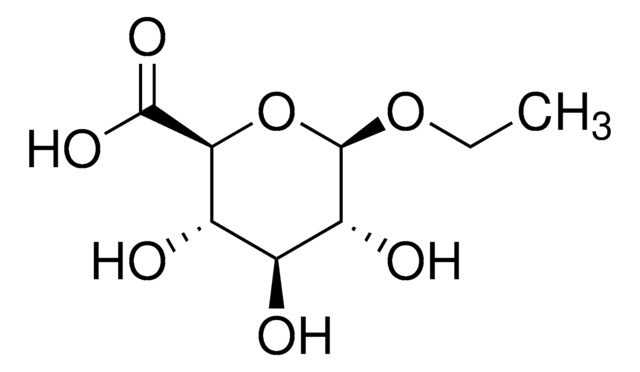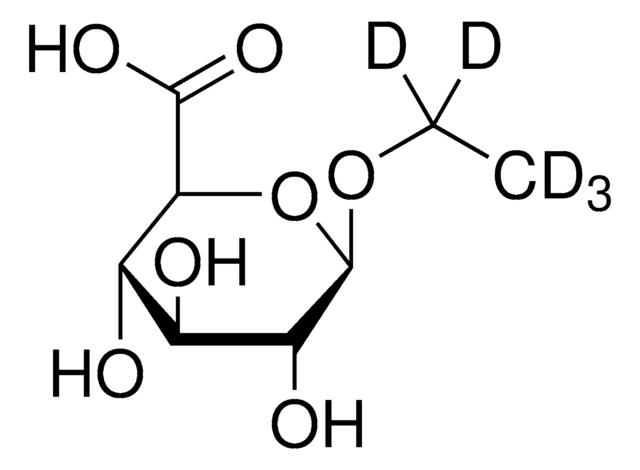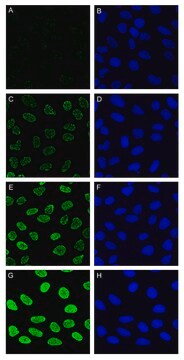推薦產品
等級
certified reference material
品質等級
形狀
liquid
特點
Snap-N-Spike®/Snap-N-Shoot®
包裝
ampule of 1 mL
製造商/商標名
Cerilliant®
濃度
100 μg/mL in methanol
技術
gas chromatography (GC): suitable
liquid chromatography (LC): suitable
應用
forensics and toxicology
格式
single component solution
儲存溫度
−20°C
SMILES 字串
O[C@H]1[C@H](O)[C@@H](C(O)=O)O[C@@H](OCC)[C@@H]1O
InChI
1S/C8H14O7/c1-2-14-8-5(11)3(9)4(10)6(15-8)7(12)13/h3-6,8-11H,2H2,1H3,(H,12,13)/t3-,4-,5+,6-,8+/m0/s1
InChI 密鑰
IWJBVMJWSPZNJH-UQGZVRACSA-N
尋找類似的產品? 前往 產品比較指南
一般說明
乙基-β-D-葡萄糖醛酸酯(EtG)是乙醇的一种水溶性、稳定的代谢物,被用作酒精滥用监测的常规生物标志物。极少部分乙醇降解为 EtG,可以在体液和头发中检测到。
應用
- 通过超高效液相色谱(UHPLC)结合串联质谱(MS/MS)对人血浆和尿液样品中的不同酒精代谢物进行多残留分析
- 使用优化的超临界液相色谱-串联质谱法(SFC-MS/MS)分离并定量分析人尿液样品中的高极性药物及其代谢物方法
- 使用配对离子电喷雾质谱(PIESI-MS)联用高效液相色谱(HPLC)方法检测和测量尿样中的药物代谢物
- 评估毛发样品的样品制备对超高效液相色谱-电喷雾电离-串联质谱法定量分析乙基-β-D-葡萄糖醛酸盐的影响
- 通过台式气相色谱联用质谱联用(GC-MS)分析人类尿液样品中作为尿液生物标志物的乙基-β-D-葡萄糖醛酸酯
特點和優勢
- 完全符合 ISO/IEC 17025 和 ISO 17034 认证
- 附综合分析证书(CoA),包括稳定性、均匀性、浓度准确性、不确定性和可追溯性数据
- 通过实时稳定性研究严格测试,以确保准确性和保质期
- 使用合格的精密天平进行重量准备,以确保最小不确定性
- 氩气环境下火焰密封,装入安瓿以便长期保存
- 提供方便的 DEA 豁免格式,以提高实验室效率
法律資訊
相關產品
訊號詞
Danger
危險分類
Acute Tox. 3 Dermal - Acute Tox. 3 Inhalation - Acute Tox. 3 Oral - Flam. Liq. 2 - STOT SE 1
標靶器官
Eyes
儲存類別代碼
3 - Flammable liquids
水污染物質分類(WGK)
WGK 1
閃點(°F)
49.5 °F - closed cup
閃點(°C)
9.7 °C - closed cup
分析證明 (COA)
輸入產品批次/批號來搜索 分析證明 (COA)。在產品’s標籤上找到批次和批號,寫有 ‘Lot’或‘Batch’.。
文章
Review of clinically relevant ethanol metabolites and analytical method development for the analysis of ethyl glucuronide and ethyl sulfate in urine matrix.
Review of clinically relevant ethanol metabolites and analytical method development for the analysis of ethyl glucuronide and ethyl sulfate in urine matrix.
The method shown uses HILIC mode on an Ascentis® Express OH5 column to retain both analytes well, making it very likely to be more robust and reliable, as well as highly MS-friendly.
我們的科學家團隊在所有研究領域都有豐富的經驗,包括生命科學、材料科學、化學合成、色譜、分析等.
聯絡技術服務










